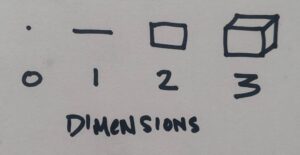What does TWOD mean in crosswords and why does it answer the clue [Flat, for short]?
TWOD is often the answer to the crossword clue
[Flat, for short] or [Lacking depth]

The answer TWOD is one of the weirder-looking answers in the cruciverse, but perhaps the place where it most makes sense.
Seen outside of crosswords as “2-D,” it’s short for “two-dimensional.” The adjective is most often used to describe geometric forms like squares and circles, which–unlike their 3-D (“THREED” in crosswordese) forms, cubes and spheres–lack depth. So TWOD is often described by clues like
- [Lacking depth]
- [Like line drawing]
- [Depthless, for short]
- [Less than solid]
- [On a plane, for short]
In everyday life, we’re most likely to experience TWOD things as the result of light, [Like most movies] that don’t require special glasses. Somehow, I’ve yet to come across a clue that refers to the most common 2-D sight: a shadow.
A potential clue for TWOD that might be the most suitable of all has somehow never yet seen the light of day: [Like a crossword grid].
Whenever I come across TWOD, I can’t help but thinking of that wonderful math-fantasy, the slim (but not quite 2-D) 19th century novel, Flatland: A Romance of Many Dimensions, written by Edwin A. Abbott, an English schoolmaster. Set in a two-dimensional world and narrated by a square named A Square, the novel is quite imaginative and funny and definitely worth a read, though it is regrettably misogynist at times.
I did just learn that the author’s middle initial, A., stands for Abbott, making him Edwin Abbott Abbott, a name that might well reflect Edwin’s parents were first cousins. (I guess they were first cousins, then spouses.) For those keeping track, that means his name contains two Abbotts, four Bs, four Ts, but zero Ds.
While I can’t claim the novel is particularly deep, it has a sort of wonderful, demented logic that’s an absolute pleasure. Highly recommended:















